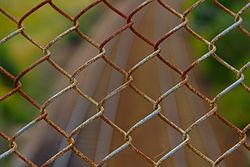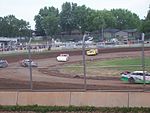- Chain-link fencing
-
A chain-link fence (also referred to as wire netting, chain-wire fence, cyclone fence or hurricane fence) is a type of woven fence usually made from galvanized or LLDPE-coated steel wire. The wires run vertically and are bent into a zig-zag pattern so that each "zig" hooks with the wire immediately on one side and each "zag" with the wire immediately on the other. This forms the characteristic diamond pattern seen in this type of fence.
Contents
Sizes and uses
In the United States, fencing usually comes in 20 rod and 50 ft rolls which can be joined by "unscrewing" one of the end wires and then "screwing" it back in so that it hooks both pieces. Common heights include 3 ft, 3 ft 6 in, 4 ft, 5 ft, 6 ft, 7 ft, 8 ft, 10 ft, and 12 ft, though almost any height is possible. Common mesh gauges are 9, 11, and 11.5. For tennis courts and ball parks the most popular height is 10 ft.
The popularity of chain-link fence is due to its relatively low cost and ease of installation. A further advantage is that due to the open weave, chain-link fences are transparent, and do not obscure sunlight from either side of the fence. If a semi-opaque fence is desired, this can be achieved by the insertion of slats into the mesh.
Installation
The installation of chain-link fence involves setting posts into the ground and attaching the fence to them. The posts may be steel tubing, timber or concrete and may be driven into the ground or set in concrete (preferably both). End, corner or gate posts, commonly referred to as 'terminal posts', must either be set in concrete footing or otherwise anchored to prevent leaning under the tension of a stretched fence. Posts set between the terminal posts are called line posts and are set in concrete footings (or in some locations driven in place) at intervals not to exceed 10 feet. The fence is attached at one end, stretched, and attached at the other, the excess being easily removed by "unscrewing" a wire. Finally it is tied to the line posts with aluminum wire. In many cases a bottom tension wire, sometimes referred to as coil wire, may be stretched between terminal posts to help minimize the in and out movement that occurs at the bottom of the chain-link mesh between posts. Once stretched, this wire should be secured to the line posts and the chain-link mesh "hog ringed" to the tension wire 2' on center. The installation of this wire is generally done prior to the installation of the chain-link mesh.
Development of chain-link fencing
In the United Kingdom the firm of Barnard, Bishop & Barnard was established in Norwich to produce chain-link fencing by machine. The process was developed by Charles Barnard in 1844 based on cloth weaving machines (up until that time Norwich had a long history of cloth manufacture).[1]
Anchor Fence (established in 1891) was the first US company to manufacture chain-link fencing by machines using equipment imported from Belgium.
Manufacturing
The manufacturing of chain-link fencing is called weaving. A metal wire, often galvanized to reduce corrosion, is pulled along a rotating long and flat blade, thus creating a somewhat flattened spiral. The spiral continues to rotate past the blade and winds its way through the previous spiral that is already part of the fence. When the spiral reaches the far end of the fence, the spiral is cut near the blade. Next, the spiral is pressed flat and the entire fence is moved up, ready for the next cycle. The end of every second spiral overlap the end of every first spiral. The machine clamps both ends and gives them a few twists. This makes the links permanent.
An improved version of the weaving machine winds two wires a round the blade at once, thus creating a double helix. One of the spirals is woven through the last spiral that is already part of the fence. This improvement allows the process to advance twice as fast[2].
Notable uses
- Used to notable effect in the Gehry Residence by Frank Gehry
- Wrestling steel cage matches
- Backstops used in baseball and softball fields
- Before the advent of gravel trap in the later half of the 1980s, chain-link fencing was used as catch fences in racetracks to slow out-of-control cars down before they impact barriers. In the 2000s they continued to be used at American dirt tracks.
- Many parks in London were replaced with chain-link fencing during the Second world war when the original iron and steel railings were removed for the war effort (Though many are now being replaced)[3].
See also
- Temporary fencing
- Chicken wire
- Iron
- Wire gauze
Notes
- ^ Ward, Ken. Victorian Norwich. A History of Norwich, 28 November 2006, p. 6.
- ^ Chain link weaving machine - video
- ^ English Heritage - London Squares and Open Spaces] (Accessed 27 August 2011)
External links
Categories:- Fences
Wikimedia Foundation. 2010.



